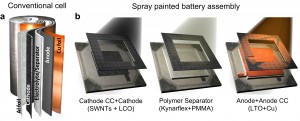Spray-on battery, 3D printing
 Rice University demos a process to spray-on batteries. This is Another step towards fully automated fabrication.
Rice University demos a process to spray-on batteries. This is Another step towards fully automated fabrication.
It was easy to predict that 3D printing would be able to make electronic parts. The process Rice uses probably doesn’t actually need 3D printing to work but it fits the concept. Multiple layers of different materials are sprayed on a surface to create a battery.
Circuits are already being made using normal 2D printers by varying the thickness of the traces to create resistors and conductors. By using a 2 or 3 different materials the full range of electronic parts could be printed directly into the circuit so a robot could literally print a copy of itself. Stratasys and Optomec have already printed electronics.
The spray-on battery will make it easier to build batteries of different shapes and sizes. It will also make it possible for nearly anyone to make batteries anywhere in the world. This can drastically reduce the real costs in terms of time and materials.
How to innovate: Sony camcorder with projector
The full list of outcomes for video is:
- Recording
- Storing
- Editing
- Locating / Selecting
- Viewing
- Disposing
Doing each of those anywhere, anytime, for whoever, for the price desired with no hassle is the ultimate.
Including a projector on the camcorder satisfied an outcome that was under-satisfied. It also utilized existing components so the extra feature was less cost than an extra device.
Future innovations will be in editing, and selected sharing. As I’ve mentioned in other posts augmented or diminished reality could be useful in a camcorder.



 Predictive Innovation Training
Predictive Innovation Training Predictive Innovation: Core Skills Book
Predictive Innovation: Core Skills Book RoundSquareTriangle.com
RoundSquareTriangle.com